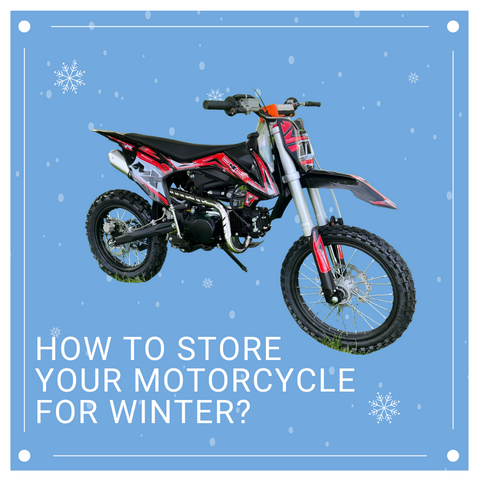
Updated: 24.4.25
Winter is here, and for motorcycle owners, that means one thing: storage season. While the thrill of riding may be put on hold, winter is the perfect time to protect your bike so it’s ready to roar back to life come spring. Proper winter storage goes beyond just parking your motorcycle in a corner—it’s about preserving performance, preventing damage, and extending your bike’s life.
From battery care and fuel stabilisation to gear storage and common mistakes to avoid, this guide walks you through everything you need to winterise your motorcycle the right way.
Indoor vs. Outdoor Motorcycle Storage
Indoor Storage (Best Option)
If you have space inside your home or garage, indoor storage provides the best protection from weather, moisture, and theft. Ensure the space is clean, dry, and well-ventilated. Even indoors, it’s smart to cover your motorcycle and maintain the battery.
Unheated Garage Storage
An unheated garage is a decent middle ground. Use a high-quality motorcycle cover and consider a battery tender to prevent power drain. Keeping the bike off the cold floor with plywood or a stand will also protect the tyres and suspension.
Outdoor Storage
Storing your motorcycle outside is less ideal but manageable with the right setup. Use a waterproof, UV-resistant, and breathable cover. Add a tarpaulin sheet for extra protection and lock everything securely.
10-Step Winter Storage Checklist
1. Clean Your Bike
Give your motorcycle a full wash and dry before storage to remove bugs, dirt, and debris. This helps prevent corrosion and preserves the finish.
2. Change the Oil and Filter
Old oil can contain contaminants that damage your engine over time. A fresh oil change and clean filter keep things in top shape during the off-season.
3. Lubricate Moving Parts
Apply quality lubricant to the chain, cables, controls, and pivot points. Don’t forget the chain—clean it thoroughly and re-lube it to prevent rust and wear.
4. Add Fuel Stabiliser
Top off the tank and add a stabiliser to prevent fuel degradation. Run the engine for a few minutes to distribute the stabiliser through the fuel system.
5. Check Fluid Levels
Inspect and top off brake fluid, coolant, and transmission fluid. If brake fluid is over a year old or discoloured, consider replacing it to avoid corrosion.
6. Empty the Carburettor
If your motorcycle uses a carburettor, drain it to prevent fuel gumming. This step ensures easy starting and clean performance post-storage.
7. Plug the Exhaust and Airbox
Prevent critters and moisture from entering by plugging the exhaust and airbox with breathable material or foam.
8. Inflate Tyres or Use a Stand
Inflate your tyres to the recommended pressure. Use a paddock or centre stand to avoid flat spots and take pressure off the suspension.
9. Maintain the Battery
Charge the battery, disconnect it, and store it in a dry place. Use a trickle charger or float charger to maintain battery health.
10. Cover the Motorcycle
Use a breathable, well-fitted motorcycle cover to protect against dust, moisture, and scratches.
Extra Tips
Long-Term Storage
Follow the same steps for any extended non-use period. Check in monthly to rotate the tyres and inspect fluids and battery.
Using Professional Storage
If space is limited, consider a professional motorcycle storage service. Look for climate-controlled units with battery maintenance and basic servicing options.
Insurance and Registration
You may be able to suspend portions of your insurance while your bike is in storage. Don’t forget to check your registration expiration date.
Riding Gear Storage
Clean and dry all riding gear. Store helmets in protective bags and keep gloves, jackets, and boots in a cool, dry space to extend their lifespan.
Common Mistakes to Avoid
- Storing the bike uncovered or with plastic that traps moisture
- Forgetting to clean it beforehand
- Skipping oil and filter changes
- Not using a fuel stabiliser
- Leaving tyres under-inflated
- Ignoring the battery
- Leaving the tank empty or the carburettor full
- Storing near chemicals or fertiliser
FAQs
Do I need to start my motorcycle during winter?
If properly stored, starting the bike is unnecessary and may even introduce moisture into the engine.
Should I change coolant before storage?
Yes, especially if it’s near due. Old coolant can become acidic and damage your engine.
Can I use car antifreeze?
No. Use motorcycle-specific antifreeze to avoid seal damage from silicates in car versions.
How should I care for leather parts?
Clean and apply leather conditioner to prevent drying or cracking. Store in a cool, dry space if removable.
Final Thoughts
Don’t let winter catch you off guard. With these tips, you’ll keep your motorcycle safe, sound, and ready to roll when spring hits. Treat winter storage like an investment—because that’s exactly what it is.
Get Ready for Spring
Looking after your motorcycle in winter means one thing: more smiles per mile when riding season returns.






Share:
What Is A Stator on A Motorcycle? How Do Stators Work?
Why Is Go Karting Good For You in 2024?